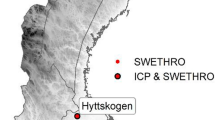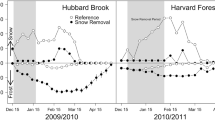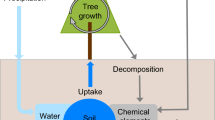Abstract
Whole-tree harvesting, i.e. harvesting of stems, branches and tops, has become increasingly common during recent decades due to the increased demand for renewable energy. Whole-tree harvesting leads to an increase in base cation losses from the ecosystem, which can counteract recovery from acidification. An increase in weathering rates due to higher temperatures is sometimes suggested as a process that may counteract the acidifying effect of whole-tree harvesting. In this study the potential effect of increasing temperature on weathering rates was compared with the increase in base cation losses following whole-tree harvesting in spruce forests, along a temperature gradient in Sweden. The mechanistic model PROFILE was used to estimate weathering rates at National Forest Inventory sites at today’s temperature and the temperature in 2050, as estimated by two different climate projections. The same dataset was used to calculate base cation losses following stem-only and whole-tree harvesting. The calculations showed that the increase in temperature until 2050 would result in an increase in the base cation weathering rate of 20–33 %, and that whole-tree harvesting would lead to an increase in base cation losses of 66 % on average, compared to stem-only harvesting. A sensitivity analysis showed that moisture changes are important for future weathering rates, but the effect of the temperature change was dominating even when the most extreme moisture changes were applied. It was concluded that an increase in weathering rates resulting from higher temperatures would not compensate for the increase in base cation losses following whole-tree harvesting, except in the northernmost part of Sweden.







Similar content being viewed by others
References
Aherne J, Posch M, Forsius M, Lehtonen A, Härkönen K (2012) Impacts of forest biomass removal on soil nutrient status under climate change: a catchment-based modelling study for Finland. Biogeochemistry 107:471–488. doi:10.1007/s10533-010-9569-4
Akselsson C, Westling O (2005) Regionalized nitrogen budgets in forest soils for different deposition and forestry scenarios in Sweden. Global Ecol Biogeogr 14:85–95. doi:10.1111/j.1466-822X.2004.00137.x
Akselsson C, Holmqvist J, Alveteg M, Kurz D, Sverdrup H (2004) Scaling and mapping regional calculations of soil chemical weathering rates in Sweden. Water Air Soil Poll: Focus 4:671–681. doi:10.1023/B:WAFO.0000028386.89557.fa
Akselsson C, Westling O, Sverdrup H, Holmqvist J, Thelin G, Uggla E, Malm G (2007) Impact of harvest intensity on long-term base cation budgets in Swedish forest soils. Water Air Soil Poll: Focus 7:201–210. doi:10.1007/s11267-006-9106-6
Akselsson C, Westling O, Alveteg M, Thelin G, Fransson A-M, Hellsten S (2008) The influence of N load and harvest intensity on the risk of P limitation in Swedish forest soils. Sci Total Environ 404:284–289. doi:10.1016/j.scitotenv.2007.11.017
Akselsson C, Hultberg H, Karlsson PE, Pihl Karlsson G, Hellsten S (2013) Acidification trends in south Swedish forest soils 1986–2008: slow recovery and high sensitivity to sea-salt episodes. Sci Total Environ 444:271–287. doi:10.1016/j.scitotenv.2012.11.106
Belyazid S, Westling O, Sverdrup H (2006) Modelling changes in forest soil chemistry at 16 Swedish coniferous forest sites following deposition reduction. Environ Pollut 144:596–609. doi:10.1016/j.envpol.2006.01.018
Berg B, McClaugherty C (2003) Plant litter: decomposition, humus formation, carbon sequestration, 2nd edn. Springer, Berlin
Bergh J, Nilsson U, Kjartansson B, Karlsson M (2010) Impact of climate change on the productivity of silver birch, Norway spruce and Scots pine stands in Sweden and economic implications for timber production. Ecol Bull 53:185–195
Brady NC, Weil RR (1999) The nature and properties of soils, 12th edn. Prentice Hall Inc, Upper Saddle River
Brandt M, Ejhed H, Rapp L (2008) Näringsbelastning på Östersjön och Västerhavet 2006: Underlag till Sveriges PLC5-redovisning till HELCOM. Swedish Environmental Protection Agency Report 5815, Stockholm (In Swedish with English summary)
Brandtberg PO, Olsson B (2012) Changes in the effects of whole-tree harvesting on soil chemistry during 10 years of stand development. Forest Ecol Manag 277:150–162. doi:10.1016/j.foreco.2012.04.019
Brantley S (2008) Kinetics of mineral dissolution. In: Brantley S, Kubicki J, White A (eds) Kinetics of water-rock interaction. Springer, New York, pp 151–210
Campbell J, Rustad L, Boyer E, Christopher S, Driscoll C, Fernandez I, Groffman P, Houle D, Kiekbusch J, Magill A, Mitchell M, Ollinger S (2009) Consequences of climate change for biogeochemical cycling in forests of northeastern North America. Can J For Res 39:264–284. doi:10.1139/X08-104
Cosby BJ, Hornberger GM, Galloway JN, Wright RF (1985) Modeling the effects of acid deposition: assessment of a lumped parameter model of soil water and streamwater chemistry. Water Resour Res 21:51–63. doi:10.1029/WR021i001p00051
Cosby BJ, Ferrier RC, Jenkins A, Wright RF (2001) Modelling the effects of acid deposition: refinements, adjustments and inclusion of nitrogen dynamics in the MAGIC model. Hydrol Earth Syst Sci 5:499–517. doi:10.5194/hess-5-499-2001
Egnell G, Nohrstedt HÖ, Weslien J, Westling O, Örlander G (1998) Miljökonsekvensbeskrivning av skogsbränsleuttag, asktillförsel och övrig näringskompensation. National Forest Agency Report 1:1998, Jönköping (In Swedish)
Ehret U, Zehe E, Wulfmeyer V, Warrach-Sagi K, Liebert J (2012) Should we apply bias correction to global and regional climate model data? Hydrol Earth Syst Sci 16:3391–3404. doi:10.5194/hess-16-3391-2012
Evans CD, Cullen JM, Alewell C, Kopácek J, Marchetto A, Moldan F, Prechtel A, Rogora M, Veselý J, Wright R (2001) Recovery from acidification in European surface waters. Hydrol Earth Syst Sci 5(3):283–297. doi:10.5194/hess-5-283-2001
Fölster J, Wilander A (2002) Recovery from acidification in Swedish forest streams. Environ Pollut 117:379–389. doi:10.1016/S0269-7491(01)00201-9
Futter MN, Klaminder J, Lucas RW, Laudon H, Köghler SJ (2012) Uncertainty in silicate mineral weathering rate estimates: source partitioning and policy implications. Environ Res Lett 7:1–8. doi:10.1088/1748-9326/7/2/024025
Gbondo-Tugbawa SS, Driscoll CT, Aber JD, Likens GE (2001) Validation of a new integrated biogeochemical model (PnET-BGC) at a northern hardwood forest ecosystem. Water Resour Res 37:1057–1070. doi:10.1029/2000WR900375
Graf Pannatier E, Thimonier A, Schmitt M, Walthert L, Waldner P (2011) A decade of monitoring at Swiss long-term forest ecosystem research (LWF) sites: can we observe trends in atmospheric acid deposition and in soil solution acidity? Environ Monit Assess 174:3–30. doi:10.1007/s10661-010-1754-3
Hägglund B (1985) A new Swedish National Forest Survey. Swedish University of Agricultural Sciences Report 37, Uppsala (In Swedish with English summary)
Hedin L, Granat L, Likens G, Buishand A, Galloway J, Butler T, Rodhe H (1994) Steep declines in atmospheric base cations in regions of Europe and North America. Nature 367:351–354. doi:10.1038/367351a0
Hellsten S, Akselsson C, Olsson B, Belyazid S, Zetterberg T (2008) Effekter av skogsbränsleuttag på markförsurning, näringsbalanser och tillväxt: Uppskalning baserat på experimentella data och modellberäkningar som grund för kartläggning av behov av askåterföring. IVL Swedish Environmental Research Institute Report B1798, Stockholm (In Swedish with English summary)
Hindar A, Henriksen A, Kaste Ø, Tørseth K (1995) Extreme acidification in small catchments in southwestern Norway associated with a sea salt episode. Water Air Soil Poll 85:547–552. doi:10.1007/BF00476886
Hodson ME, Langan SJ, Wilson MJ (1996) A sensitivity analysis of the PROFILE model in relation to the calculation of soil weathering rates. Appl Geochem 11:835–844. doi:10.1016/S0883-2927(96)00048-0
Hultberg H, Ferm M (2004) Temporal changes and fluxes of sulphur and calcium in wet and dry deposition, internal circulation as well as in run-off and soil in a forest at Gårdsjön, Sweden. Biogeochemistry 68:355–363
Iwald J, Löfgren S, Stendahl J, Karltun E (2013) Acidifying effect of removal of tree stumps and logging residues as compared to atmospheric deposition. For Ecol Manag 290:49–58. doi:10.1016/j.foreco.2012.06.022
Johns TC, Gregory JM, Ingram WJ, Johnson CE, Jones A, Lowe JA, Mitchell JFB, Roberts DL, Sexton DMH, Stevenson DS, Tett SFB, Woodage MJ (2003) Anthropogenic climate change for 1860 to 2100 simulated with the HadCM3 model under updated emissions scenarios. Clim Dynam 20:583–612. doi:10.1007/s00382-002-0296-y
Jönsson C, Warfvinge P, Sverdrup H (1995) Uncertainty in predicting weathering rates and environmental stress factors with the profile model. Water Air Soil Poll 81:1–23. doi:10.1007/BF00477253
Kellomäki S, Peltola H, Nuutinen T, Korhonen K, Strandman H (2007) Sensitivity of managed boreal forests in Finland to climate change, with implications for adaptive management. Philos T Roy Soc B 363:2341–2351. doi:10.1098/rstb.2007.2204
Kjellström E, Nikulin G, Hansson U, Strandberg G, Ullerstig A (2011) 21st century changes in the European climate: uncertainties derived from an ensemble of regional climate model simulations. Tellus 63A:24–40. doi:10.1111/j.1600-0870.2010.00475.x
Klaminder J, Lucas RW, Futter MN, Bishop KH, Köhler SJ, Egnell G, Laudon H (2011) Silicate mineral weathering rate estimates: are they precise enough to be useful when predicting the recovery of nutrient pools after harvesting? Forest Ecol Manag 261:1–9. doi:10.1016/j.foreco.2010.09.040
Koseva I, Watmough S, Aherne J (2010) Estimating base cation weathering rates in Canadian forest soils using a simple texture-based model. Biogeochemistry 101:183–196. doi:10.1007/s10533-010-9506-6
Langner J, Persson C, Robertson L, Ullerstig A (1996) Air pollution assessment study using the MATCH Modelling System. Application to sulphur and nitrogen compounds over Sweden 1994. Swedish Meteorological and Hydrological Institute, Report no. 69, Norrköping
Laudon H (2008) Recovery from episodic acidification delayed by drought and high sea salt deposition. Hydrol Earth Syst Sci 12:363–370. doi:10.5194/hess-12-363-2008
Lind P, Kjellström E (2008) Temperature and precipitation changes in Sweden; a wide range of model-based projections for the 21st century, Swedish Meteorological and Hydrological Institute Reports Meteorology Climatology No. 113, Norrköping
Lindgren F, Rue H, Lindström J (2011) An explicit link between Gaussian fields and Gaussian Markov random fields: the stochastic partial differential equation approach. J Roy Stat Soc B 73:423–498. doi:10.1111/j.1467-9868.2011.00777.x
Marklund L-G (1988) Biomass functions for pine, spruce, and birch in Sweden. Department of Forest Taxation, Swedish University of Agricultural Sciences (SLU) Report 45, Uppsala (In Swedish with English summary)
Nakićenović N, Alcamo J, Davis G, de Vries B, Fenhann J, Gaffin S, Gregory K, Grübler A (2000) Special Report on Emissions Scenarios, Working Group III, Intergovernmental Panel on Climate Change (IPCC). Cambridge University Press, Cambridge
Netherer S, Schopf A (2010) Potential effects of climate change on insect herbivores in European forests: General aspects and the pine processionary moth as specific example. For Ecol Manag 259:831–838. doi:10.1016/j.foreco.2009.07.034
Nyiri A, Gauss M, Klein H (2009) Transboundary air pollution by main pollutants (S, N, O3) and PM. MSC-W Data Note 1:2009
Pihl Karlsson G, Akselsson C, Hellsten S, Karlsson PE (2011) Reduced European emissions of S and N: effects on air concentrations, deposition and soil water chemistry in Swedish forests. Environ Pollut 159:3571–3582. doi:10.1016/j.envpol.2011.08.007
Posch M, Reinds GJ (2009) A very simple dynamic soil acidification model for scenario analyses and target load calculations. Environ Model Softw 24:329–340. doi:10.1016/j.envsoft.2008.09.007
Reinds GJ, Posch M, Leemans R (2009) Modelling recovery from soil acidification in European forests under climate change. Sci Tot Environ 407:5663–5673. doi:10.1016/j.scitotenv.2009.07.013
Roeckner E, Bäuml G, Bonaventura L, Brokopf R, Esch M, Giorgetta M, Hagemann S, Kirchner I, Kornblueh L, Manzini E, Rhodin A, Schlese U, Schulzweida U, Tompkins A (2003) The atmospheric general circulation model ECHAM5. Part I: Model description. Technical Report, Max Planck Institute for Meteorology, MPI-Report 349
Rue H, Martino S, Chopin N (2009) Approximate Bayesian inference for latent Gaussian models using integrated nested laplace approximations. J Roy Stat Soc B 71:319–392
Samuelsson P, Jones CG, Willén U, Ullerstig A, Gollvik S, Hansson U, Jansson C, Kjellström E, Nikulin G, Wyser K (2011) The Rossby Centre Regional Climate model RCA3: model description and performance. Tellus A 63:4–23. doi:10.1111/j.1600-0870.2010.00478.x
Skjelkvåle B, Mannio J, Wilander A, Andersen T (2001) Recovery from acidification of lakes in Finland, Norway and Sweden 1990–1999. Hydrol Earth Syst Sci 5(3):327–337. doi:10.5194/hess-5-327-2001
Skjelkvåle B, Borg H, Hindar A, Wilander A (2007) Large scale patterns of chemical recovery in lakes in Norway and Sweden: importance of seasalt episodes and changes in dissolved organic carbon. Appl Geochem 22:1174–1180. doi:10.1016/j.apgeochem.2007.03.040
STFI (2003) Ecocyclic pulp mill—‘KAM’: final report 1996–2002. Swedish Pulp and Paper Research Institute (STFI), KAM Report A100, Stockholm
Strömqvist J, Arheimer B, Dahné J, Donnelly C, Lindstrom G (2012) Water and nutrient predictions in ungauged basins: set-up and evaluation of a model at the national scale. Hydrol Sci J 57(2):229–247. doi:10.1080/02626667.2011.637497
Sverdrup H (1990) The kinetics of base cation release due to chemical weathering. Lund University Press, Lund
Sverdrup H, Warfvinge P (1993) Calculating field weathering rates using a mechanistic geochemical model (PROFILE). Appl Geochem 8:273–283. doi:10.1016/0883-2927(93)90042-F
Sverdrup H, Warfvinge P, Wickman T (1998) Estimating the weathering rate at Gårdsjön using different methods. In: Hultberg H, Skeffington R (eds) Experimental reversal of acid rain effects. The Gårdsjön project. Wiley, London, pp 231–249
Sverdrup H, Martinson L, Alveteg M, Moldan F, Kronnäs V, Munthe J (2005) Modeling recovery of Swedish Ecosystems from Acidification. Ambio 34(1):25–31
Swedish Forest Agency (2008) Skogliga konsekvensanalyser 2008: SKA-VB 08. Swedish Forest Agency Report 25, Jönköping (In Swedish)
Swedish Forest Agency (2014) Swedish statistical yearbook of forestry 2014. Swedish Forest Agency, Jönköping (In Swedish with some features in English)
van Breemen N, Jenkins A, Wright RF, Beerling DJ, Arp WJ, Berendse F, Beier C, Collins R, van Dam D, Rasmussen L, Verburg PSJ, Wills MA (1998) Impacts of elevated carbon dioxide and temperature on a boreal forest ecosystem (CLIMEX Project). Ecosystems 1:345–351
Wallman P, Svensson M, Sverdrup H, Belyazid S (2005) ForSAFE: an integrated process-oriented forest model for long-term sustainability assessments. For Ecol Manag 207:19–36. doi:10.1016/j.foreco.2004.10.016
Warfvinge P, Sverdrup S (1995) Critical load of acidity to Swedish forest soils. Methods, data and results. Lund University, Department of Chemical Engineering II Report 5
Wright R, Jenkins A (2001) Climate change as a confounding factor in reversibility of acidification: RAIN and CLIMEX projects. Hydrol Earth Syst Sci 5(3):477–486. doi:10.5194/hess-5-477-2001
Yang W, Andréasson J, Graham LP, Olsson J, Rosberg J, Wetterhall F (2010) Distribution-based scaling to improve usability of regional climate model projections for hydrological climate change impact studies. Hydrol Res 41:211–229. doi:10.2166/nh.2010.004
Zak SK, Beven K, Reynolds B (1997) Uncertainty in the estimation of critical loads: a practical methodology. Water Air Soil Poll 98:297–316
Zetterberg T, Olsson BA, Löfgren S, von Brömssen C, Brandtberg PO (2013) The effect of harvest intensity on long-term calcium dynamics in soil and soil solution at three coniferous sites in Sweden. For Ecol Manag 302:280–294. doi:10.1016/j.foreco.2013.03.030
Zheng D, Hunt ER, Running SW (1993) A daily soil temperature model based on air temperature and precipitation for continental applications. Clim Res 2:183–191
Acknowledgments
We acknowledge funding from The Swedish Environmental Protection Agency, through the project CLEO (Climate Change and Environmental Objectives), and the Swedish Research Council, Formas, through the projects Hydroimpacts 2.0 and QWARTS (Quantifying Weathering Rates for Sustainable Forestry). Forest and soil input data were obtained from the Swedish National Forest Inventory database, managed by the Department of Forest Resource Management at the Swedish University of Agricultural Sciences (SLU), and from the Soil Geochemistry database, managed by the Geological Survey of Sweden (SGU).
Author information
Authors and Affiliations
Corresponding author
Additional information
Responsible Editor: Stephen D. Sebestyen
Rights and permissions
About this article
Cite this article
Akselsson, C., Olsson, J., Belyazid, S. et al. Can increased weathering rates due to future warming compensate for base cation losses following whole-tree harvesting in spruce forests?. Biogeochemistry 128, 89–105 (2016). https://doi.org/10.1007/s10533-016-0196-6
Received:
Accepted:
Published:
Issue Date:
DOI: https://doi.org/10.1007/s10533-016-0196-6




